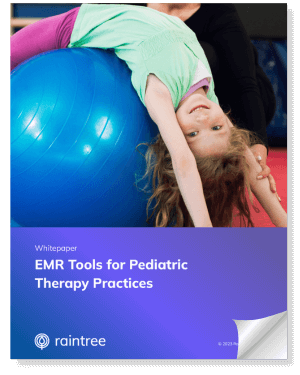Specialized therapy requires specialized solutions. Does your practice have these pediatric therapy software essentials?
Delivering care to young children differs greatly from treating adult patients, which means your practice will have unique requirements for your tech stack, from specialized EMR software to patient engagement tools to integrated billing systems.
Instead of opting for a software tailored only to adult therapy, pediatric clinics need a system with specialty-specific documentation, interactive family engagement tools, and configurable practice management systems.
How Pediatric Therapy Software Is Different
Aside from physical therapy and occupational therapy providers, applied behavioral analysis (ABA) therapists and speech-language pathologists (SLP) benefit from software that makes it easy to document visits and quickly complete therapy progress notes. It’s important to leverage specialty-specific workflows and customizable forms that let you focus more closely on individualized treatment plans, rather than exhausting time on extensive data entry.
Pediatric Therapy EMR Software
Your EMR system is an integral part of daily workflows, from completing therapy notes, building a plan of care, and managing therapy documentation. But when you’re working with software that’s not designed specifically for pediatric therapy, your practice might have to rely on inefficient workarounds in your clinical and administrative processes. It gets even more complicated at a multi-disciplinary practice, or one that serves patients of all ages. That’s why it’s so important to choose the right EMR solution.
Specialized Clinical Documentation
When you utilize sub-specialty templates, you can reduce the time spent on sourcing correct codes for diagnoses and treatments. As an added benefit, these templates empower users to easily collect all the necessary information needed (all-in-one platform) to properly verify insurance and manage patient revenue. In addition, customizable tables, forms and engagement narratives allow you to create targeted clinical questionnaires and better track patient outcomes that may be unique to each child’s needs (i.e. developmental growth).
Pediatric EMR Software and Patient Privacy
Patient information and visit data are only valuable if you can retrieve and share it with ease. In the past, the usual approach to storing electronic medical records (EMR) involved installing software on company hard drives, but now, cloud-based solutions are becoming the norm.
With one secure, single source database, you can access patient information from multiple locations and devices, which can be ideal when multiple therapists are involved in a patient’s care or when referring physicians need to stay up-to-date on a child’s progress.
However, most importantly, you need a solution that securely protects sensitive client information and that supports your compliance to the Health Insurance Portability and Accountability Act (HIPAA).
Telehealth for Families and Young Patients
As more people discover the convenience of virtual care, pediatric therapy practices should consider implementing telehealth. Teletherapy sessions gives patients and their parents the ability to participate in visits together, from the comfort and convenience of home or elsewhere. With screen sharing capabilities, virtual waiting rooms, interactive whiteboards, and other features, virtual platforms can create an engaging experience for patient, parent and provider. Additionally, telehealth provides families with more opportunities to fit therapy sessions into their hectic schedules, and provides access to patients in rural or remote areas without clinics nearby.
Without the right software in place, medical billing can be a time-consuming, labor-intensive process for your team. While older approaches require significant manual intervention and management of printed paperwork, high level automation helps streamline all your revenue cycle and billing processes in one place.
Billing in Pediatric Rehabilitation Settings
Young patients have unique needs, and so does your practice. Pediatric therapists should adopt a billing software that includes a pediatric format for notes along with goal banks, assessment content and standardized test data relevant to the population they serve.
Pediatric therapists should search for software that includes a comprehensive set of reporting filters that allow you to quickly sort through claim status codes, evaluate staff productivity and manage sub-specialty specific reimbursements.
Patient Engagement and Pediatric Therapy
Aside from billing, patient engagement is another major priority for pediatric therapy practices. Due to the fact that a majority of their patients are minors, pediatric providers should heavily focus on connecting with parents via online portals or self check-in kiosks. You can also find platforms that facilitate scheduled or on demand engagement campaigns, automate appointment reminders, host customizable patient-provider dashboards, and deliver electronic statements (eStatements).
By automating many of your day-to-day tasks, you can improve operational efficiency and increase revenue, while empowering your team to focus more energy on patient care. Additionally, an integrated task manager can help you automate internal task triggers, track progress and monitor staff or user activity.
Finding the Right Pediatric Therapy Software
Managing a pediatric therapy practice will always be a complicated endeavor, but the right software can make all the difference in how you optimize clinical efficiencies, stabilize financial processes, customize and configure workflows, and deliver excellent patient care.
To learn more about how Raintree offers providers an all-inclusive EHR and practice management software platform that streamlines every facet of the patient experience, from patient intake through final payment, request a demo today!



